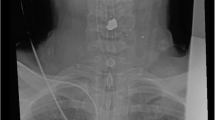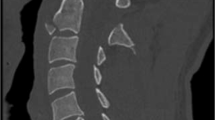Abstract
Study design:
Case report.
Objective:
To present an unusual traumatic neurologic pathology caused by gunshot injury.
Setting:
Spine unit of Department of Trauma and Orthopaedic Surgery, University Medical School, Charité – Campus Benjamin Franklin, Berlin, Germany.
Method and result:
A 35-year-old male sustained a gunshot injury from a machine gun. The projectile caused a fracture of the left pedicle of Th10. The spinal cord was indirectly damaged by cavitation that caused a Brown-Séquard syndrome (BSS). After a microscopically assisted posterior revision at T9/10 with removal of bullet and bone fragments from the spinal canal and debridement of the bullet cavity via extended fenestrectomy the patient gained his motor function back. The sensory deficit remained unchanged.
Conclusion:
BSS can be caused by bullet-related injury of the spinal canal with no direct damage of neural structures. The initial treatment is always based on the total injury pattern. Possible spinal cord injuries are only clarified after restitution of vital functions. Decompression of neural structures in shotgun injury is indicated in incomplete paraplegia, injury of intra-abdominal hollow organs or high velocity bullet wounds. Through debridement and decompression of neural structures and chronic damage caused by foreign body granulomas can be prevented. Secondary destabilization of the spine should be avoided.
Similar content being viewed by others
Introduction
Brown-Séquard syndrome (BSS) is a rare form of incomplete paraplegia first described in 1849 by Charles-Edouard Brown-Séquard.1 It is characterized by hemilateral spinal cord injury with ipsilateral motoric paresis and disturbed contralateral pain and temperature sensation.
BSS is associated with a number of triggering causes like acceleration and deceleration trauma,2, 3 cervical disc prolapse1, 4, 5 or spinal and epidural hematoma.6, 7, 8 BSS has the best prognosis of all incomplete paraplegia syndromes with regard to the neurological outcome.9 Seventy percent of all BSS patients regained independency in their daily routine and in 80–90% bladder and bowel function normalized completely.10
We report about a patient with BSS caused by a thoracic gunshot wound with the projectile penetrating the spinal canal without a direct injury of the spinal cord.
Case history
A 35-year-old man sustained a thoracic gunshot injury from a machine gun. On arrival at the emergency room, the patient was intubated and the patient was hemodynamically unstable. The external sign of injury was a leftsided submamillar bullet entry wound (Figure 1). No exit wound was seen. Standardized initial treatment in the shock room was performed according to the ATLS®-protocol (advanced trauma life support). Damage control included emergency thoracotomy with pericardial fenestration, diaphragmatic suture, direct vascular suture to close the aortic injury as well as video-assisted thoracoscopy. Emergency laparotomy was also necessary with oversewing of the cardia and debridement of the bullet canal. Following the initial stabilization of the patient, further diagnostics were performed in conjunction with the ‘secondary survey’. The spinal X-rays (Figure 2) as well computed tomography (CT) of the thoracic spine (Figure 3) revealed a projectile-related fracture of the left pedicle of T10 with displacement of bone and bullet fragments into the spinal canal. After extubation of the patient, the neurological examination disclosed BSS with asymmetrical paraparesis and dissociated sensory deficits below the T10 level. There was a unilateral ipsilateral motor deficit of 0/5 BMC (British Medical Research Council).
After initial stabilizing of the patient a microscopically assisted posterior revision at T9/10 level has been performed. Bone and bullet fragments were removed from the spinal canal via wide fenestrectomy and partial resection of the destroyed left pedicle T10 as well as debridement of the spinal canal (Figure 4). The intraoperative investigation of the spinal cord did not indicate a dura lesion caused by fragments of the bullet or by fragments of the pedicle.
The motor deficit improved in the postoperative course. Five weeks after surgery, the strength of the affected segment-indicating muscles was measured at 3/5 BMC and the patient was thus mobilized with the aid of a walker. At the time of discharge, the patient had regained good control of bowel function but contralateral sensory deficits and disturbed bladder function remained.
Two follow-up examinations 5 and 12 months after surgery were carried out in our outpatient department.
Five months after surgery, the motor deficit was 4/5 BMC but bladder function and sensory deficit remained unchanged.
One year after the accident, the motor deficit had regressed and bladder function returned to normal. The patient was able to walk without assistance. The contralateral sensory deficit remained.
Discussion
In the United States, gunshot wounds are the second most frequent cause of spinal cord injuries. In Central Europe on the other hand, gunshot wounds are a rare injury pattern.11 The thoracic spine is most frequently affected followed by injuries of the cervical spine and the thoracolumbar region, which may develop into complete or incomplete paraplegia independent of the injury mechanism. In contrast to patients with complete paraplegia, those with incomplete paraplegia have the best chances of recovery with respect to a possible neurological regeneration. Spinal gunshot wounds are usually stable spinal injuries. Fractures of the pedicles or facets due to transversal penetration of the projectile are responsible for acute or chronic instabilities of the spine. There is usually no relevant instability in unilateral pedicle or facet injuries.12
Gunshot injuries lead to tissue damage via three mechanisms: (I) direct tissue damage; (II) shock wave; (III) cavitation.13, 14, 15, 16
In contrast to stab wounds, gunshot wounds can result in neurological deficits even if the projectile does not directly injure the spinal cord. When the bullet penetrates the tissue, enough energy is released by accompanying physical phenomena to cause indirect injuries to the spinal cord.17
Gunshot injuries from low velocity bullets result in direct tissue damage. High velocity bullets (V>1000 feet/s) produce furthermore addition a temporary bullet cavity that can be up to 30 times larger than the bullet itself.13, 15, 18 This effect can lead to the destruction of surrounding tissue requiring debridement. Treatment guidelines for combat-related high velocity bullet wounds require exploration with debridement and decompression of the affected spinal segment.19 In contrast, civilian gunshot wounds caused by low-velocity bullets require debridement and decompression only for injuries to vessels or intra-abdominal hollow organs.19 This type of gunshot injury is usually not accompanied by secondary damage due to cavitation or initiation of a shock wave.
Results of prospective studies have shown that removal of the projectile and debridement of the lumbar spine lead to a significant improvement of motor deficits in incomplete paraplegia.20 Neurological regeneration of incomplete paraplegia lesions in segments T12–L4 improved significantly only after removal of the projectile. In complete paraplegia, there is no significant difference in the neurological outcome between removing or leaving the projectile or decompressing the spinal canal.21 Projectiles or their fragments that are not removed are encapsulated by low vascularized fibrous tissue and can, depending on the site, cause secondary chronic back pain due to compression of neural structures. Tindel et al22 demonstrated in experimental animal studies that specific metals in projectiles can cause varying degrees of neural damage independent of the initial mechanical injury. In our case, the spinal injury was at the level of T10 and outside the zone (T12–L5) in which a significant improvement of neurological regeneration can be expected after spinal decompression. In the present case, an intra-abdominal hollow organ was perforated after penetration of the projectile. Owing to the velocity of the bullet, the spinal cord was indirectly injured by the shock wave and cavitation. In addition, during the destruction caused by impact, bullet and bone fragments were displaced into the spinal canal when the projectile hit the T10 pedicle. To prevent scarification and formation of granuloma we therefore carried out decompression of the spinal canal with debridement via wide fenestrectomy with removal of bone and bullet fragments. Instrumentation of the affected vertebral segment was unnecessary, since this was a unilateral injury of the lamina and pedicle.
References
Rumanna CS, Baskin DS . Brown-Séquard syndrome produced by cervical disc herniation: case report and literature review. Surg Neurol 1996; 45: 359–361.
Kettaneh A, Biousse V, Bousser MG . Neurological complications after roller coaster rides: an emerging new risk? Presse Med 2000; 29: 175–180.
Bateman DE, Pople I . Brown-Séquard at a theme park. Lancet 1998; 352: 1902.
Antich PA, Sanjuan AC, Girvent FM, Simo JD . High cervical disc herniation and Brown-Séquard syndrome. A case report and review of the literature. J Bone Joint Surg Br 1999; 81: 462–463.
Kobayashi N, Asamoto S, Doi H, Sugiyama H . Brown-Séquard syndrome produced by cervical disc herniation: report of two cases and review of the literature. Spine J 2003; 3: 530–533.
Narberhaus B, Rivas I, Vilalta J, Abos J, Ugarte A . Transient Brown-Séquard syndrome due to spontaneous spinal epidural hematoma. Neurologia 2002; 17: 384–387.
Ehsan T, Henderson JM, Manepalli AN . Epidural hematoma producing Brown-Séquard syndrome: A case due to ruptured hemangioma with magnetic resonance imaging findings. J Neuroimaging 1996; 6: 62–63.
Shen CC, Wang YC, Yang DY, Wang FH, Shen BB . Brown-Séquard syndrome associated with Horneŕs syndrome in cervical epidural hematoma. Spine 1995; 20: 244–247.
Pollard ME, Apple DF . Factors associated with improved neurologic outcomes in patients with incomplete tetraplegia. Spine 2003; 28: 33–39.
Kirschblum SC, ÓConnor KC . Predicting neurologic recovery in traumatic cervical spinal cord injury. Arch Phys Med Rehabil 1998; 79: 1456–1466.
Platz A, Stahel PF, Kossmann T, Trentz O . Civilian gunshot injuries to the spine: diagnostik procedures and therapeutic Concepts. Eur J Trauma 2001; 27: 104–109.
Yoshida GM, Garland D, Waters RL . Gunshot wounds to the spine. Orthop Clin North Am 1995; 26: 109–116.
Charters III AC, Charters AC . Wounding mechanism of very high velocity projectiles. J Trauma 1976; 16: 464–470.
DeMuth Jr WE . Bullet velocity and design as determinants of wounding capability. J Trauma 1969; 9: 27–38.
Hopkinson DA, Marshall TK . Firearm injuries. Br J Surg 1967; 54: 344–353.
Russotti GM, Sim FH . Missile wounds of the extremities. A current concepts review. Orthopedics 1985; 8: 1106–1116.
Waters RL, Adkins RH, Yakura J, Sie I . Profiles of spinal cord injury and recovery after gunshot injury. Clin Orthop 1991; 267: 14–21.
Amato JL et al. High velocity missile injury: an experimental study of the retentive forces of tissue. Am J Surg 1974; 127: 454–459.
Isiklar ZU, Lindsey RW . Gunshot wounds to the spine. Injury 1998; 29 (Suppl 1): S7–S12.
Waters RL, Adkins RH . The effects of removal of bullet fragment retained in the spinal canal. Spine 1991; 168: 934–939.
Jacobs GB, Berg RA . The treatment of acute spinal cord injuries in a war zone. J Neurosurg 1971; 34: 164–167.
Tindel NL, Marcillo AE, Tay B, Bunche RB, Eismont FJ . The effect of surgical implanted bullet fragments on the spinal cord in a rabbit model. JBJS 2001; 83: 884–890.
Author information
Authors and Affiliations
Rights and permissions
About this article
Cite this article
Reinke, M., Robinson, Y., Ertel, W. et al. Brown-Séquard syndrome caused by a high velocity gunshot injury: a case report. Spinal Cord 45, 579–582 (2007). https://doi.org/10.1038/sj.sc.3101986
Published:
Issue Date:
DOI: https://doi.org/10.1038/sj.sc.3101986







